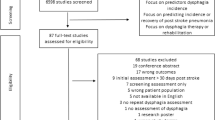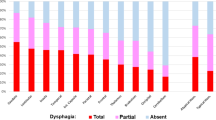Abstract
Patients’ awareness of their disability after stroke represents an important aspect of functional recovery. Our study aimed to assess whether patient awareness of the clinical indicators of dysphagia, used routinely in clinical assessment, related to an appreciation of “a swallowing problem” and how this awareness influenced swallowing performance and outcome in dysphagic stroke patients. Seventy patients were studied 72 h post hemispheric stroke. Patients were screened for dysphagia by clinical assessment, followed by a timed water swallow test to examine swallowing performance. Patient awareness of dysphagia and its significance were determined by detailed question-based assessment. Medical records were examined at three months. Dysphagia was identified in 27 patients, 16 of whom had poor awareness of their dysphagic symptoms. Dysphagic patients with poor awareness drank water more quickly (5 ml/s vs. <1 ml/s, p = 0.03) and took larger volumes per swallow (10 ml vs. 6 ml, p = 0.04) than patients with good awareness. By comparison, neither patients with good awareness or poor awareness perceived they had a swallowing problem. Patients with poor awareness experienced numerically more complications at three months. Stroke patients with good awareness of the clinical indicators of dysphagia modify the way they drink by taking smaller volumes per swallow and drink more slowly than those with poor awareness. Dysphagic stroke patients, regardless of good or poor awareness of the clinical indicators of dysphagia, rarely perceive they have a swallowing problem. These findings may have implications for longer-term outcome, patient compliance, and treatment of dysphagia after stroke.


Similar content being viewed by others
References
DG Smithard PA O’Neill R England C Park R Wyatt D Martin J Morris (1997) ArticleTitleThe natural history of dysphagia following a stroke. Dysphagia 12 188–193 Occurrence Handle1:STN:280:ByiH2c%2FntlA%3D Occurrence Handle9294937
EJ Roth (1991) ArticleTitleMedical complications encountered in stroke rehabilitation. Phys Med Rehab Clin North Am 2 563–578
DG Smithard PA O’Neill C Park J Morris R Wyatt R England D Martin (1996) ArticleTitleComplication and outcome after acute stroke. Does dysphagia matter? Stroke 27 1200–1204 Occurrence Handle1:STN:280:BymB1M%2FgtFM%3D Occurrence Handle8685928
DH Barer (1989) ArticleTitleThe natural history and functional consequences of dysphagia after hemispheric stroke. J Neurol Neurosurg Psychiatry 52 236–241 Occurrence Handle1:STN:280:BiaC1MbgtVw%3D Occurrence Handle2564884
G Mann GJ Hankey D Cameron (1999) ArticleTitleSwallowing function after stroke prognosis and prognostic factors at 6 months. Stroke 30 744–748 Occurrence Handle1:STN:280:DyaK1M3gsFehtw%3D%3D Occurrence Handle10187872
J Logemann (1986) ArticleTitleTreatment of aspiration related to dysphagia: an overview. Dysphagia 1 34–38
GN Ali TM Laundl KL Wallace DJ deCarle IJS Cook (1996) ArticleTitleInfluence of cold stimulation on the normal pharyngeal swallow response. Dysphagia 11 2–8 Occurrence Handle1:STN:280:BymC2cfhvVU%3D Occurrence Handle8556873
S Elmståhl M Bülow O Ekberg M Petersson H Tegner (1999) ArticleTitleTreatment of dysphagia improves nutritional conditions in stroke patients. Dysphagia 14 61–66 Occurrence Handle10028034
J Low C Wyles T Wilkinson R Sainsbury (2001) ArticleTitleThe effect of compliance on clinical outcomes for patients with dysphagia on videofluoroscopy. Dysphagia 16 123–127 Occurrence Handle10.1007/s004550011002 Occurrence Handle1:STN:280:DC%2BD3MzlsFWmtw%3D%3D Occurrence Handle11305222
C Gordon R Langton Hewer D Wade (1987) ArticleTitleDysphagia in acute stroke. BMJ 295 411–414 Occurrence Handle1:STN:280:BieD3c7ksFE%3D Occurrence Handle3115478
H Nilsson O Ekberg R Olsson B Hindfelt (1998) ArticleTitleDysphagia in stroke: a prospective study of quantitative aspects of swallowing in dysphagic patients. Dysphagia 13 32–38 Occurrence Handle1:STN:280:DyaK1c%2FlsVWksg%3D%3D Occurrence Handle9391228
SM McGlynn DL Schacter (1989) ArticleTitleUnawareness of deficits in neuropsychological syndromes. J Clin Exp Neuropsychol 11 143–205 Occurrence Handle1:STN:280:BiaC2srjsFA%3D Occurrence Handle2647781
MJ Babinski (1914) ArticleTitleContribution a l’etude des troubles mentaux dans l’hemiplegie organique cerebrate (Anosognosia). [Contribution to the study of mental disturbance in organic cerebral hemiplegia (Anosognosia)]. Rev Neurolog 12 845–848
DT Stuss DF Benson (1984) ArticleTitleNeuropsychological studies of the frontal lobes. Psychol Bull 95 IssueID1 3–28 Occurrence Handle1:STN:280:BimD2czhslE%3D Occurrence Handle6544432
DW Buchholz J Bosma M Donner (1985) ArticleTitleAdaptation, compensation and decompensation of the pharyngeal swallow. Gastrointest Radiol 10 235–239 Occurrence Handle1:STN:280:BiqB1cnht1I%3D Occurrence Handle4029539
K Wallace S Middleton IJ Cook (2000) ArticleTitleDevelopment and validation of a self-report symptom inventory to assess the severity of oral-pharyngeal dysphagia. Gastroenterology 118 678–687 Occurrence Handle1:STN:280:DC%2BD3c3gtVehtg%3D%3D Occurrence Handle10734019
FL Mahoney DW Barthel (1965) ArticleTitleFunctional evaluation: the Barthel index. Maryland State Med J 14 61–65 Occurrence Handle1:STN:280:CCqD28zks1I%3D
JA Logemann S Veis L Colangelo (1999) ArticleTitleA screening procedure for oropharyngeal dysphagia. Dysphagia 14 44–51 Occurrence Handle1:STN:280:DyaK1M%2FkslCmsw%3D%3D Occurrence Handle9828274
JA Logemann (1993) Manual for the videofluorographic study of swallowing, 2nd ed. Pro-Ed, Austin, TX:
TAT Hughes CM Wiles (1996) ArticleTitleClinical measurement of swallowing in health and in neurogenic dysphagia. Q J Med 89 IssueID2 109–116 Occurrence Handle1:STN:280:BymA3cnls10%3D
AJ Miller (1982) ArticleTitleDeglutition. Physiol Rev 62 IssueID1 129–184 Occurrence Handle1:STN:280:Bi2C3cnis1E%3D Occurrence Handle7034008
S Hamdy D Mikulis A Crawley S Xue H Lau S Henry NE Diamant (1999) ArticleTitleCortical activation during human volitional swallowing: an event-related fMRI study. Am J Physiol 277 G219–G225 Occurrence Handle1:CAS:528:DyaK1MXkslKnsbs%3D
RE Martin BJ Sessle (1993) ArticleTitleThe role of the cerebral cortex in swallowing. Dysphagia 8 195–202 Occurrence Handle1:STN:280:ByyA28rjtVU%3D Occurrence Handle8359039
H Nilsson O Ekberg R Olsson B Hindfelt (1996) ArticleTitleQuantitative aspects of swallowing in an elderly population. Dysphagia 11 180–184 Occurrence Handle8755461
PJ Kahrilas Lin Shezang J Chen JA Logemann (1996) ArticleTitleOropharyngeal accommodation to swallow volume. Gastroenterology 111 297–306 Occurrence Handle1:STN:280:BymA3crgvFM%3D Occurrence Handle8690194
RO Dantas MK Kern BT Massey WJ Dodds PJ Kahrilas JG Brasseur IJ Cook IM Lang (1990) ArticleTitleEffect of swallowed bolus variables on oral and pharyngeal phases of swallowing. Am J Physiol 258 G675–G681 Occurrence Handle1:STN:280:By%2BB2c%2FksVI%3D Occurrence Handle2333995
JA Logemann PJ Kahrilas J Cheng BR Pauloski PJ Gibbons AW Rademaker S Lin (1992) ArticleTitleClosure mechanisms of laryngeal vestibule during swallow. Am J Physiol 262 G338–G344 Occurrence Handle1:STN:280:By2C2s%2Fpt1E%3D Occurrence Handle1539666
S Hamdy Q Aziz JC Rothwell R Crone DG Hughes RC Tallis DG Thompson (1997) ArticleTitleExplaining oro-pharyngeal dysphagia after unilateral hemispheric stroke. Lancet 350 686–692 Occurrence Handle1:STN:280:ByiH3sjjs10%3D Occurrence Handle9291902
Acknowledgements
This study was supported by a grant from the North Western Regional Health Authority Biomedical Research Fund. We would also like to thank the Speech and Language Therapy Department of Hope Hospital for supporting this study and Elizabeth Hill for statistical advice. Shaheen Hamdy is an MRC (UK) Clinician Scientist. Maxine Power was an MRC (UK) Clinical Training Fellow. The Stroke Association funded Audrey Bowen and Pippa Tyrrell.
Author information
Authors and Affiliations
Corresponding author
Rights and permissions
About this article
Cite this article
Parker, C., Power, M., Hamdy, S. et al. Awareness of Dysphagia by Patients Following Stroke Predicts Swallowing Performance . Dysphagia 19, 28–35 (2004). https://doi.org/10.1007/s00455-003-0032-8
Issue Date:
DOI: https://doi.org/10.1007/s00455-003-0032-8





